Magical Realism & Indigenous Futures:
An Interview with Cara Romero
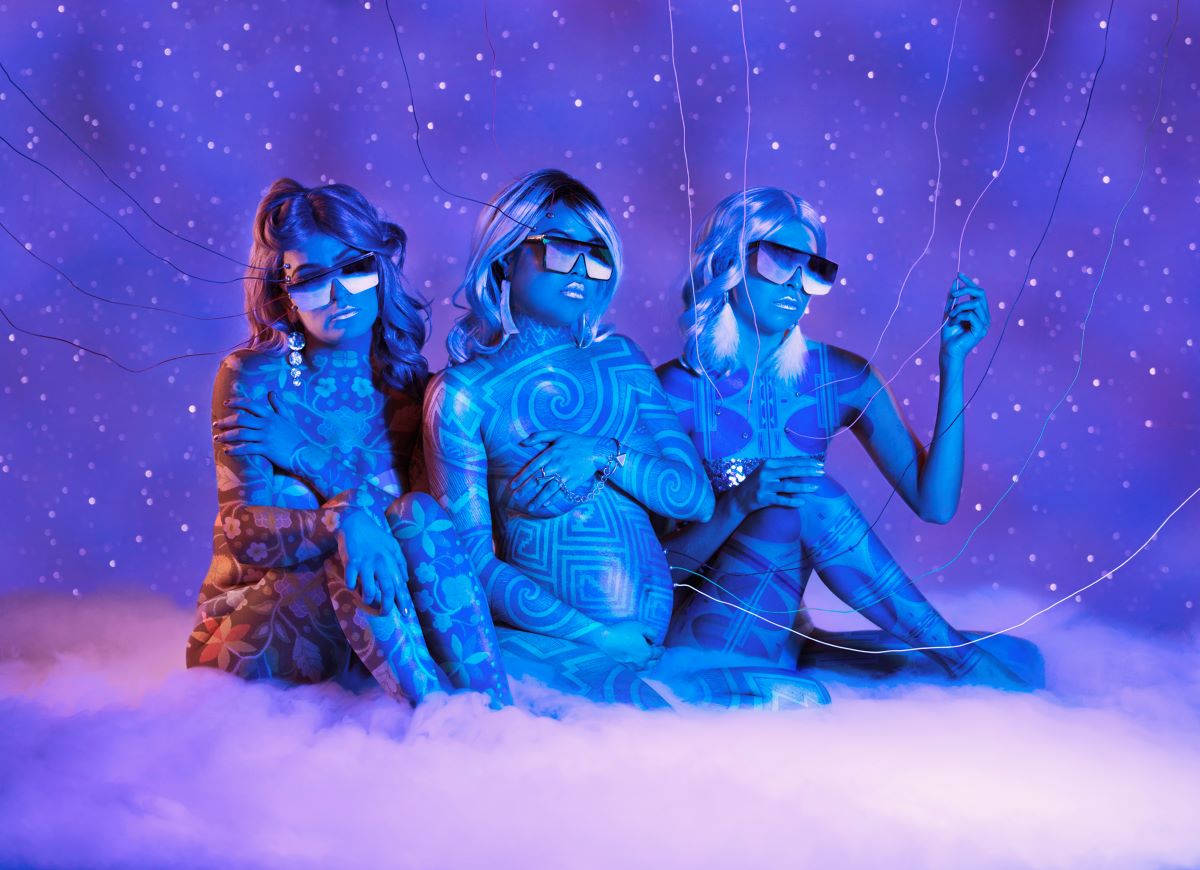
An enrolled citizen of the Chemehuevi Indian Tribe, Cara Romero’s identity informs a photographic practice that blends documentary, fine art, commercial, and editorial traditions into a visceral, theatrical approach to storytelling to represent contemporary indigeneity and lived experiences from a Native American female perspective. In conjunction with Romero’s participation in the Mexico City art fair, ZONAMACO (February 8–12, 2023), I sat down with the artist to highlight the trajectory of her career, her processes, representation, and pop culture. In her latest series—which focuses on Indigenous Futurism and Native science—elements of cultural continuum are vividly and playfully present, showcasing the knowledge in taking the past with us.
JEYou’ve experienced a few shifts in your interests, from a pursuit in cultural anthropology to an interest in photojournalism, commercial photography, and fine art, and on to your current work, which conceptually blends these practices. You’ve mentioned that in looking at work that defined the documentary genre—Edward Curtis’s black-and-white historic photographs, for instance—you felt a sense of disconnect, that the content felt disingenuous to your lived experience. Can you share your thoughts on photojournalism versus how you see contemporary storytelling through the medium of photography and staged ideas?
CRWhen I first set out to pursue photography, I imagined I would be a photo documentarian or a photojournalist. There really weren’t many Native people doing that work. What was available to reference were works by Carl Moon and Curtis. When I went to school, it was still at a time when black-and-white film was dominating the industry. I realized that we were emulating non-Native photographers’ vantage point of looking in on the culture from an outside perspective. That was one of the first moments when as a scholar, an academic, and an artist I began to question.
As a contemporary Native American person, I was very interested in our diverse identities and the realities of having many stories emerge. I didn’t want to make work that was disingenuous to these lived experiences. Our tribes couldn’t be any more different coming from the middle of the desert. Certainly there were similarities and struggles related to genocide and colonialism in reservation-era life, but I was also interested in the stories that other documentarians weren’t. I was interested in our beauty. I was interested in the shoebox of photos I grew up with. I was interested in my grandma’s era and my dad growing up on the beach—basically all the stories I really didn’t see reflected anywhere else is what deeply interested me.
Moving on to fine art and editorial practices was just a continuation of my study of the photographic medium. Then it was a very intuitive journey of the heart to move from fine arts school to actually pursuing a commercial photography degree. It’s important to note that during my studies everything switched over from analog to digital. All the distinct practices and influences were very important, but rather than remaining distinct, they culminate in my work. Documentary practice is still in the picture, as is the staged and the theatrical. In documenting people as intertribal collaboration, there is certainly editorial and identity work that embraces photography’s fine art and commercial traditions, including the importance of commercial lighting and graphic sensibilities as well.
JECan you speak to your processes?
CRI don’t often think about everything before I do it. I often find myself trusting in the process. I realized over time that the way I borrow practices from high fashion, and combining commercial with natural lighting techniques, was really about a visual language that we were all already seeing—a global reference of our collective. When I started out, photography was a special niche, and now I think we consume more photography than words in many societies. I never saw that coming.
The staging and theatrics of the work really came from being so often stuck in daydreams and my imagination for long periods of time and not actually being able to execute and produce work. These visions would build up during the mundane activities of being a mother: while I was washing dishes and folding clothes I would be off in my imagination while also thinking about contemporary issues. It would all come together in my mind’s eye, and then it became about logistics: how can I clear the calendar for a weekend and stage the production? I didn’t know a decade ago that these processes were going to be the key to storytelling. It was really very intuitive—very much the universe opening up, using all of the gifts that I had acquired up to that point in relation, also, to a deep biofeedback from the audiences. It was so well received, specifically within the Native community, that I was like, “Okay, this is what I want to do.” I found my voice.
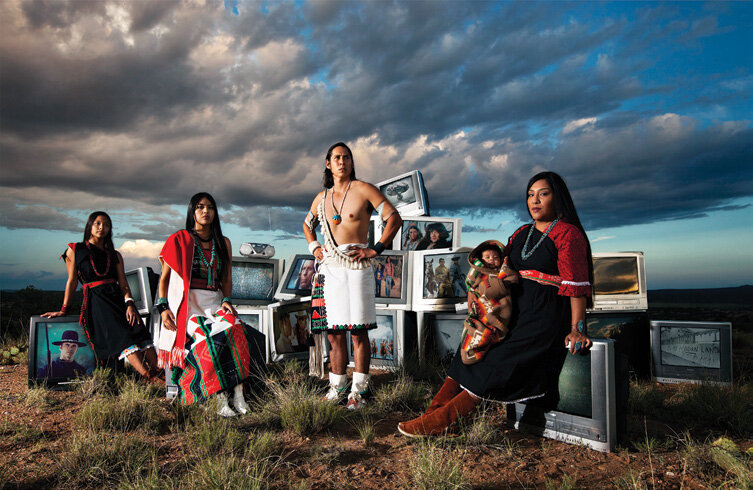
JEI love how you blend pop culture, mythos figures, and Chemehuevi creation stories in your work to address contemporary indigeneity. The surreal dreamscape of TV Indians (Color) (2017) gives subtle nods to a postmodern, Curtis-style photography and speaks to American consumerism and also to this parallel universe of how we are versus how we are portrayed in TV and media. This work documents Native people in their regalia in a landscape of new ruins. Stacks of TVs are reminiscent of the adobe ruins and the New Mexico landscape, and though the characters depicted on the TV screens are problematic and perpetuate stereotypes, they’re also beloved in our community because they were the only representation we had in Hollywood and media. Can you speak more on representation, ruins, and landscape throughout this piece?
CRI love that this image is kind of preposterous. Going through the process of picking the images that would appear on the TVs was rather funny and delightful around my home. We talked about it within our family.
A few things happen in this work. One is deep cultural privacy that I call passive resistance. We’ve had to become extremely culturally private over the past many generations for fear of persecution or for fear of those cultural practices being taken away or being judged for participating in them. So, we do them in secret in particular ways, and I think being placed on reservations, isolated from other communities, fed this privacy. That kind of created another parallel universe.
When I was very young, my grandmother would say that Native people didn’t really know that there was a great depression because they were living in a completely different way from the rest of Americans. I think that’s true today in our private communities. We often hear overused expressions of walking in two worlds and that sort of thing—it’s like we’re always in this kind of dual reality. If we throw out the categories and the separateness, how do you visually express walking in two worlds? How do you represent that all of these things are happening at the same time? These questions make me fall in love with the medium of photography even more. I think that TV Indians (Color) is a very powerful piece for all of those reasons. We can laugh with each other about all of its nuances. And laughter is medicine; laughter is healing.
JEI like that concept of visually expressing living—or walking—in two worlds. Judith LeBlanc [executive director of the Native Organizers Alliance] talks about wearing a high heel on one side and a moccasin on the other. I think that allegory is just so accurate to our experience. Going into that, you’ve spoken about how when we as Native people are examined and defined visually or culturally from outside of the culture—and it doesn’t necessarily reflect how we are in contemporary life—it causes this schism: the idea of outsiders coming in to tell us what they think is important about our culture versus storytellers from within our culture telling authentic stories. Being a Native photographer, there’s a flip of the photographic cannon. This authentic representation is so vital. In one of your artist talks, you spoke about the lack of representation—representation of women in photography, especially BIPOC women photographers—when you were starting out in the early nineties. Have you seen a shift? What do you think the future holds specifically for BIPOC and Native femme artists?
CRI see a surge of BIPOC and Native filmmakers and photographers, and I think it’s beautiful. For a long time I’ve known that we have this wealth of content. I really dove deep into the pursuit of photography and many times was questioned for that pursuit—by my family or my peers and even by myself. But I really trusted my heart and had several very special people who encouraged me to follow my heart. That was a deeply important spiritual path as a Native person to learn that we don’t have to fit any mold.
There were very powerful photographers that came before me who certainly inspired me and influenced me, and I hoped that I could be somewhere in the same universe as their artwork. As young people we need role models. For me, those were people like Shelley Niro, Jolene Rickard, Zig Jackson, and Lee Marmon. It was just half a dozen people. That was really all I could find. It was very important that I went to tribal college because I don’t know if I would’ve found them had I not ended up in an art school with a deep emphasis of knowing those who came before us. I don’t think I would’ve found that in any university or dominant-culture art program. In that way I felt very lucky to have ended up there with that influence. I am fascinated as a Gen X person—who came before the advent of the world wide web—how much the internet has connected us as Native people. We can look at the bad things about the internet and everything going digital, but for me one of the silver linings of all of that is our deep connection to each other and to each other’s stories. Maybe it’s also due to the accessibility of digital storytelling and this medium that we’re seeing phenomena like the 1491s popping up on YouTube and Reservation Dogs on Hulu.
I see innovation in our young people. I think we still have a long way to go as far as navigating the industrial art complex of being seen and how to interact with non-Native people and non-Native institutions and organizations and ways of being. Or maybe they need to adjust to our ways of being—probably a better way to move forward—to make sure that there’s inclusivity of story and innovation of the resourcefulness and creativity that comes out of marginalized communities.
I can look back and say now I understand that I was not an outlier or an outsider, but I was probably innovating. But when you’re experiencing that feeling of being an outsider or not having a place, it can feel like you’re not on the right path. I think a lot of young people see now as our time. I have experienced being an outsider to the dominant art complex as a BIPOC woman doing non-traditional art for all of these weird commercial labels. I think at some point it was very liberating to feel I was never going to make it or fit into that world because I could finally just make the work for my own community.
I was recently interviewed by the Museum of Modern Art, and it still deeply affects me. They asked why I still do the Indian Market here in Santa Fe, and the sentiment was undeniably that it was beneath me. Quite honestly, I think Indian Market is where my questions came from. When I was a kid, there was nothing bigger than being at Santa Fe Indian Market: that was the summit of Indian art at the time. And while we’ve come so far, it is in addition to Indian Market, not against it. From my experience it has only been a little movement in the last decade where museums are taking a look at their parity of BIPOC people.
Photography by women has gone from being considered a craft to being art, which is a major shift. All of these things are happening at the same time: museums putting a moratorium on buying white men’s artwork, alongside American collections having a deep reckoning with acknowledging Native Americans and people from the Asian diaspora and African Americans and so many other individuals and communities as being American artists. They’re scrambling to make sure that they’re balancing their inclusion in their collections and their exhibitions. All of a sudden we’ve arrived with not only a really strong voice but one that’s been here unnoticed for a very long time, one with a never-ending wealth of content from thousands and thousands of stories yet to be told. I find it a very exciting time that I never quite imagined would arrive, but here it is.
JEI totally agree. I also feel like because of what’s happening right now, where there’s this shift in perspective and recognition—even just by what you were talking about with the popularity of Reservation Dogs—museums defining what kind of leadership they have or what kind of art they show in a more inclusive way. I feel like sometimes there’s a thought process that we’re living in a post-colonial world when we’re not quite there yet. Yes, we have come to this point, but there’s still a long way to go, but it seems like it’s on the cusp of something.
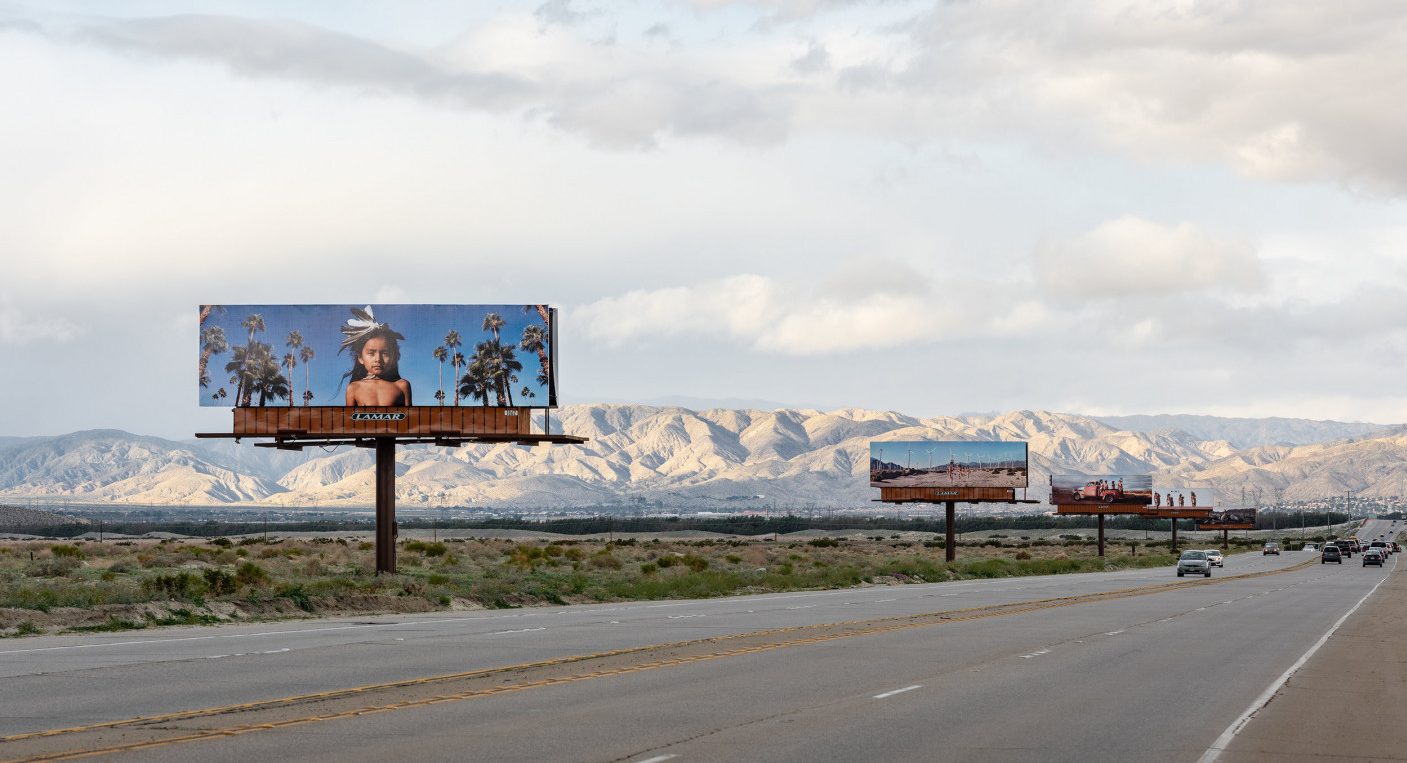
photo by Lance Gerber for Desert X
I’m thinking about this recurring theme of cultural and physical landscape. Through an Indigenous mindset, it goes beyond merely dots on a map or borders. We possess this deep spiritual connection to our landscapes and bioregions, ancestral territories that are no longer ours. This shows up in your work with the Desert X biennial, with the Jackrabbit, Cottontail & Spirits of the Desert (2019) billboard series where four mythological characters came back to visit the Coachella Valley and responded to the development of infrastructure and pristine landscape. There was an element of wanting to ground people in what it feels like, what it means that you’re on Indian land in California, and this power of them being time travelers from Chemehuevi. Can you speak more about this specific response?
CRWhen I was invited to Desert X, I was the first Indigenous person from the bioregion to participate. Chemehuevi are technically from Coachella Valley, alongside many other tribes. We have cultural protocols for even being on other Native people’s land. That was very present for me as I thought about things that artists from other nationalities and communities aren’t affected by. I don’t think that Native people can easily be wrapped up in their egos because we’re never really not just representing ourselves. There can be a lot of autobiography in our work, but we’re really beholden not only to the communities we’re citizens of, but also to larger intertribal Native America. That made the work of Desert X in Coachella Valley—where there are really four nations represented—very important to me.
I thought it would be a good starting place to approach Cahuilla people, whose reservations are in the area. We’re very social in Southern California, and I began thinking about how we’ve visited each other and shared song and other cultural exchanges for thousands of years. When I approached the Tribal Council of the Agua Caliente Band of Cahuilla Indians, where the billboards would actually be, I presented my idea of four boys from our reservation that would be spirit beings of the landscape visiting their sister tribes. They would not only be representing themselves but also something much larger, much more spiritual, which is a recurring theme in my work. In Southern California, and many other regions, our languages have built in a spiritual sense of all of those that came before us still experiencing everything around us, alongside us.

We do have references for creators and mythos but when we talk about everyday prayer, we really speak to Ivan Kurur, which translates loosely in English as “those that are around us.” They’re our grandmas, our grandpas, our great grandmas, and everyone who’s there alongside us, whether they’re cheering us on or experiencing our pain or defending our landscapes with us. The Desert X work was really having a deep visual conversation with that sense of spirit beings, the landscape, those who are all around us with the four young boys from my reservation. We had so much fun as a family making this work—family as in they’re loosely my nephews and in my community. They did such an amazing job of having that young purity of spirit.
One of the things that I found about working with young people from our reservation is how empowering it is for them to be photographed, and also how they are upfront in talking about sociopolitical issues. I think art has that power to make a space where we don’t have to have the answers, but we can certainly spark conversations that people may otherwise not be having. It’s a different source of inspiration for critical dialogue than periodicals or news sources. It resonates with people in a different way. My hope for Jackrabbit, Cottontail & Spirits of the Desert is that the people from the area, people visiting the area, people who are reckoning with what it is to be settler colonial on deeply Indigenous lands across America, could get a sense of that feeling of those that are all around us in those landscapes.
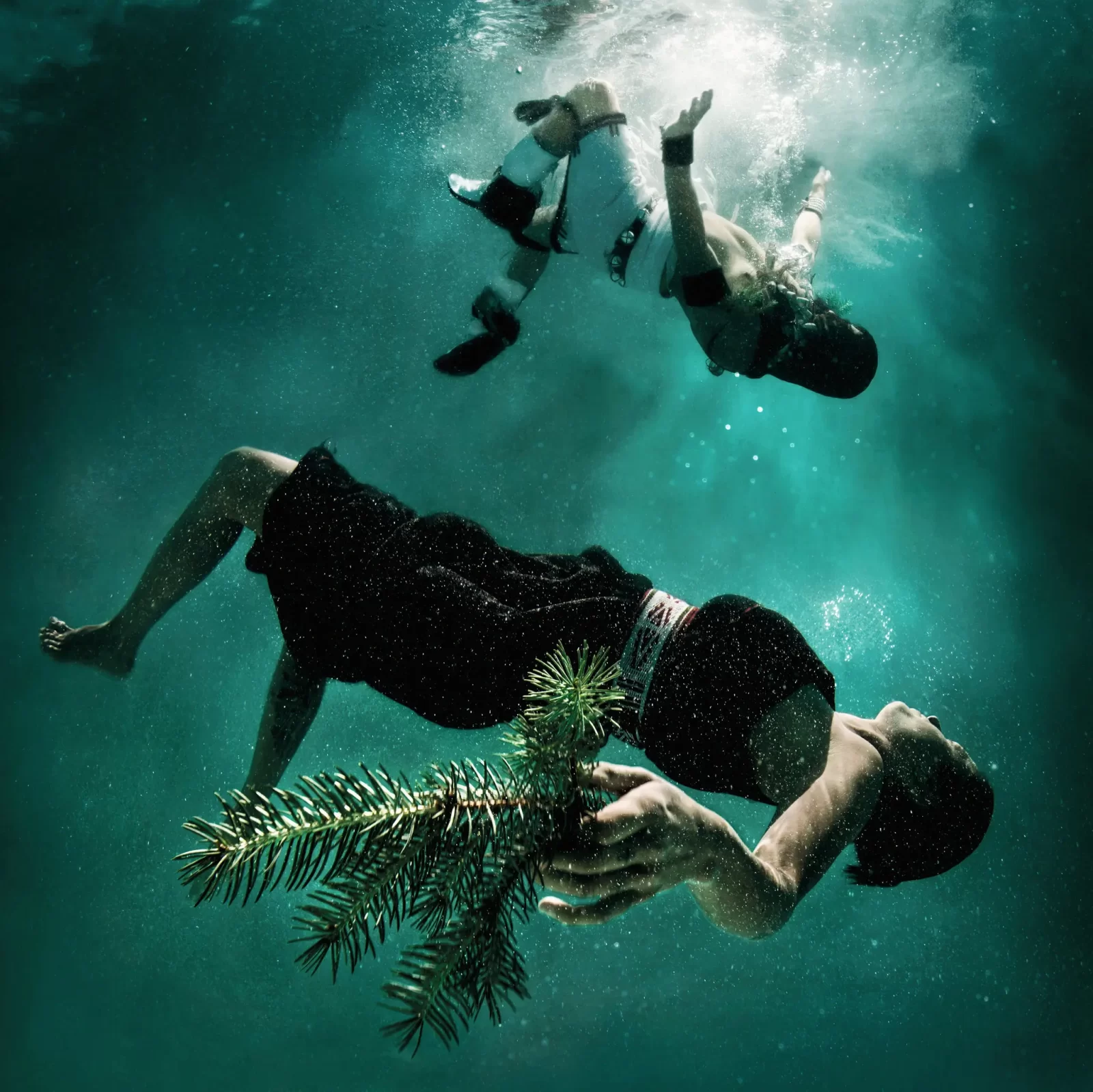
JEThat ties into the aspects of cultural memory and collective history in your work, specifically in Water Memory (2015), a series that shows Native people submerged underwater. This idea came in the response to the great flood of the Chemehuevi Valley, and in the series you involve models from tribes who were affected by flooding in the past, who are currently or will be in the future in the great flood of climate change, which is a great example of the interconnectivity in Indigenous culture between past, present, and future. One article likened your photography, specifically this series, to a kind of cultural archaeology. Do you see a difference between Native truth telling and cultural archaeology?
CRIt was a story that I grew up with that so deeply affected everything—and it affected my family, it affected generations, it affected the landscape, it continues to affect us. The way that the damming of the rivers is historically described is very linear, from a non-Native perspective of having dominion over landscape, which is deeply conflicting for Native worldviews. In really thinking about the present day and into the future, it was the same conversation about how disproportionately we were affected by the building of infrastructure, the manipulation of lands and waterscapes, the impacts of climate change, the loss of gathering spaces, the extraction of resources for the larger rights of American people and the global market. It’s a story that repeats and repeats and repeats. I often find within those stories—including within our non-Native counterparts in academia, where they’re learning these stories without the thick context of anthropology—that they don’t understand how we got to where we’re at.
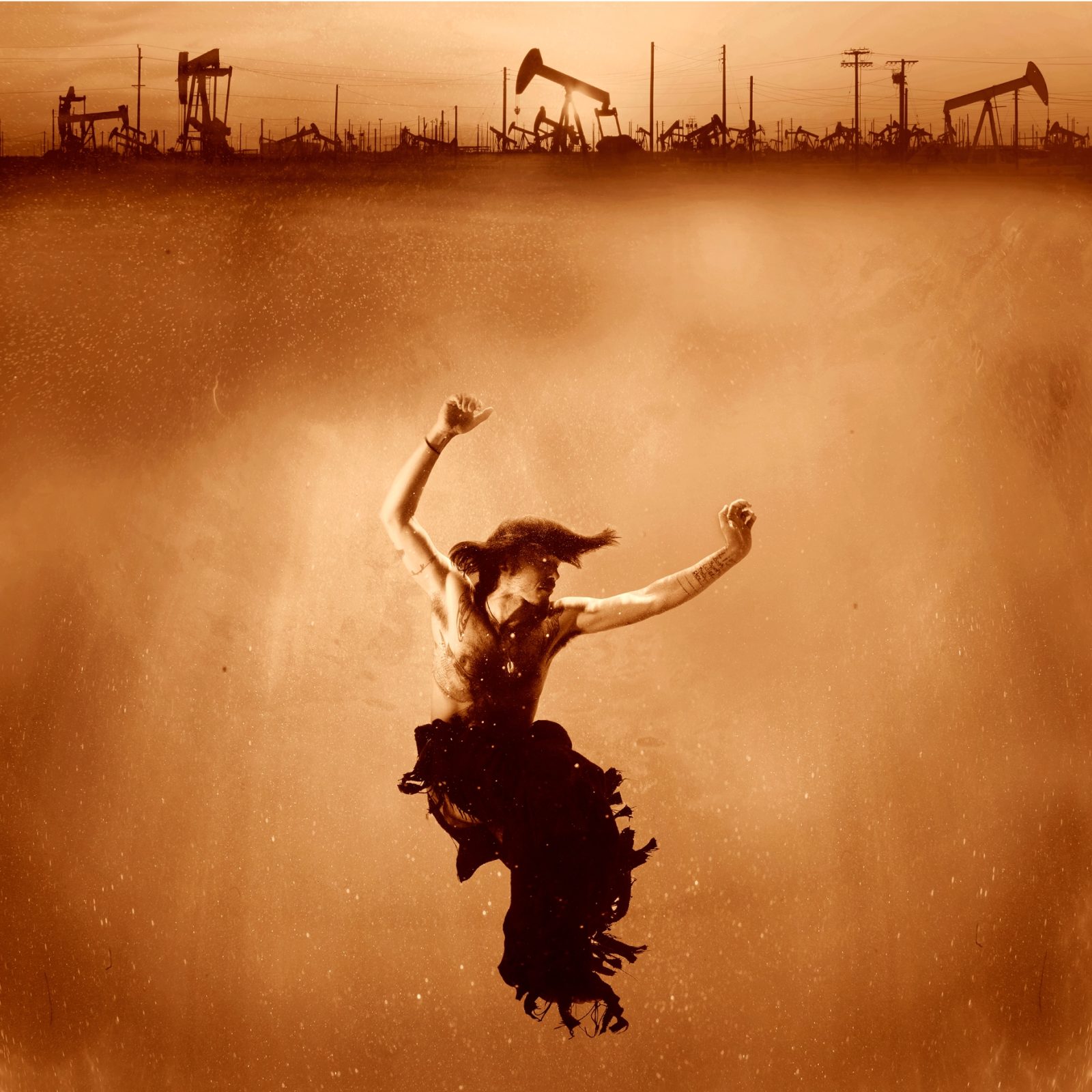
When we look from an outsider’s perspective it’s puzzling for people how we live in this reservation era. Some of our tribes are dependent on the resort economy or the oil economy but without the thread of the stories that impacted those narratives. As Native people, how can we just tell you in a way that we’re not only screaming from the hilltops or talking about the injustices? Those ways are important, but those are also the things that offset people when it comes to cross-cultural communication. Art can be a different way of telling the story of the oil boom. Oil Boom (2015) tells of when we were flooded out of our lands by the making of Lake Sakakawea, when we ended up on a chunk of clay and found oil. It may be a habit for non-Native people to think Native people are okay with or have enough resources from living off the oil economy, but if we examine the oil fields or learn more detail about specific stories like Fort Berthold, people can understand there’s a much deeper survival story. I find myself wanting to retell these stories from a different perspective: American stories from our perspective.
JEI think you do that really well in your pop culture references, specifically in 17-Mile Road (2019), a reference to the Abbey Road Beatles album, and in Last Indian Market (2015), where you brought thirteen of Santa Fe’s leading Native artists together for a playful tableau based on the Santa Fe Indiana Market and da Vinci’s The Last Supper. This was a collaboration with artist Marcus Amerman, who dresses up as Buffalo Man, and part of a series placing Buffalo Man in iconic images to recreate them with an Indian narrative. You’ve said this piece was about asserting our place in contemporary society, a parody to portray the people of our time and an artistic statement that we understand pop culture—that we’re in on it. I love this assertion that we are as Indigenous as we ever were, even though we’ve living within pop culture of contemporary times. Can you speak more on what this series brought up for you and what you want viewers to take away from it?
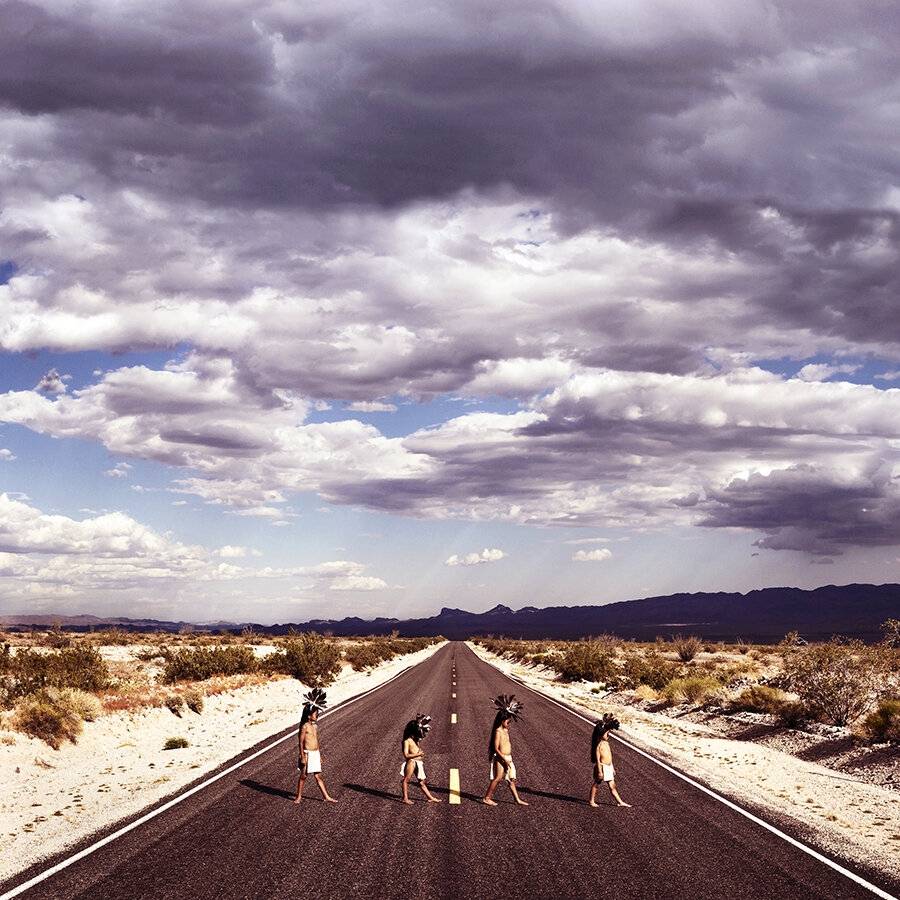
CRThe series started in 2015 very playfully, and I think it was really stepping into that voice of identity and authenticity and also that moment where I had been liberated and not worrying too much about what would be well received by non-Native people and rather focusing on Native audiences. There is a Native sense of humor that can’t be fully translated or known outside of our communities. It is such an abstract, nuanced thing, but so important to us. It really is a survival mechanism. It really is healing and medicine. (I also love that about Reservation Dogs in the sense of not explaining the sense of humor.) While I knew this work was fun and playful, I knew it was also deeply impactful for the community. It was only in hindsight that I realized it was so deeply resonant because we hadn’t really seen work like that in photography before. Like a reminder that a lot of people don’t have a sense of our existence, particularly where I’m from, but I think in many city settings and many dominant cultures, in mainstream pop culture, in subculture settings we’re often invisible.

JEAnother theme that shows up in your work is mythology. Your piece Kaa (2017) is a depiction of the Clay Woman, a deity of the Clay, who is described as warm, soft, and temperamental. Working with your friend Kaa, a practicing clay artist, you photographed her painted in clay with mesa verde pottery designs on her skin. Her hair is captured at 1/8-thousandth of a second to emphasize the temperamental nature of clay when you fire it, showcasing how she is both an artist and a vessel of the spirit of the clay. There’s very distinct aspects of time, space, place, absence, and presence in this work, as well as supernatural feminine power. Can you tell us more about how the feminine strength is highlighted in your work?
CRI have thought about this feminine strength a lot. Throughout my life I’ve been able to learn about other cultures and religions and theology and to come to know how our tribes are so diverse. For Chemehuevi women it’s a couple of things. For one, our creator is female, and that has always made so much sense to me. Like, of course!. We’re life givers; we’re the beginning of creation and bringing life into this world. Secondly, we have gender roles where I’m from. Women are very powerful, and we also have a lot of gender fluidity in Chemehuevi culture. It’s okay to be both and to move back and forth along the spectrum of identity, of gender identity. Women have always been allowed to be very strong in my community, very outspoken. I think that that is also very unique.
I grew up in the early ’80s. My grandmother was chairwoman of our tribe. We were deeply politically active. All of the aunties and women in our tribe were very powerful and allowed to take up space and be strong. So, I think that it’s part of my identity. More broadly, when I look outside of my own community at the breakdown of traditional roles, and the breakdown of our men through colonialism and genocide, at the breakdown of traditional ways of living—it has led to the disempowerment that has really also affected our women. Women have really had to carry culture, to be the backbone of our communities, to be mothers to many, to often be heads of household, which may not for some tribes be a traditional role. The third part of it—which really pisses me off—is to be so dehumanized as Native women. I get a little choked up to speak of this, but for me it’s really important to show how powerful we are, how much medicine we have, because I don’t think that that’s going to come from any man that’s here. Looking at women through photography is such a powerful tool, and it really comes from a deeply maternal place, maybe a very assertive place of wanting to counter the untrue narratives that we’ve been handed. Our bodies are very important. Our humanness, our life-giving abilities, this great burden that we’ve carried so elegantly through the last many hundreds of years are really the stories that I find myself going back to. It’s a place of comfort for me. I often find myself with only women on the set, and I really enjoy the energy of being in community, of creating, of safekeeping other women and really wanting to bolster that feminine energy within the photographs, because I think that we deserve that.
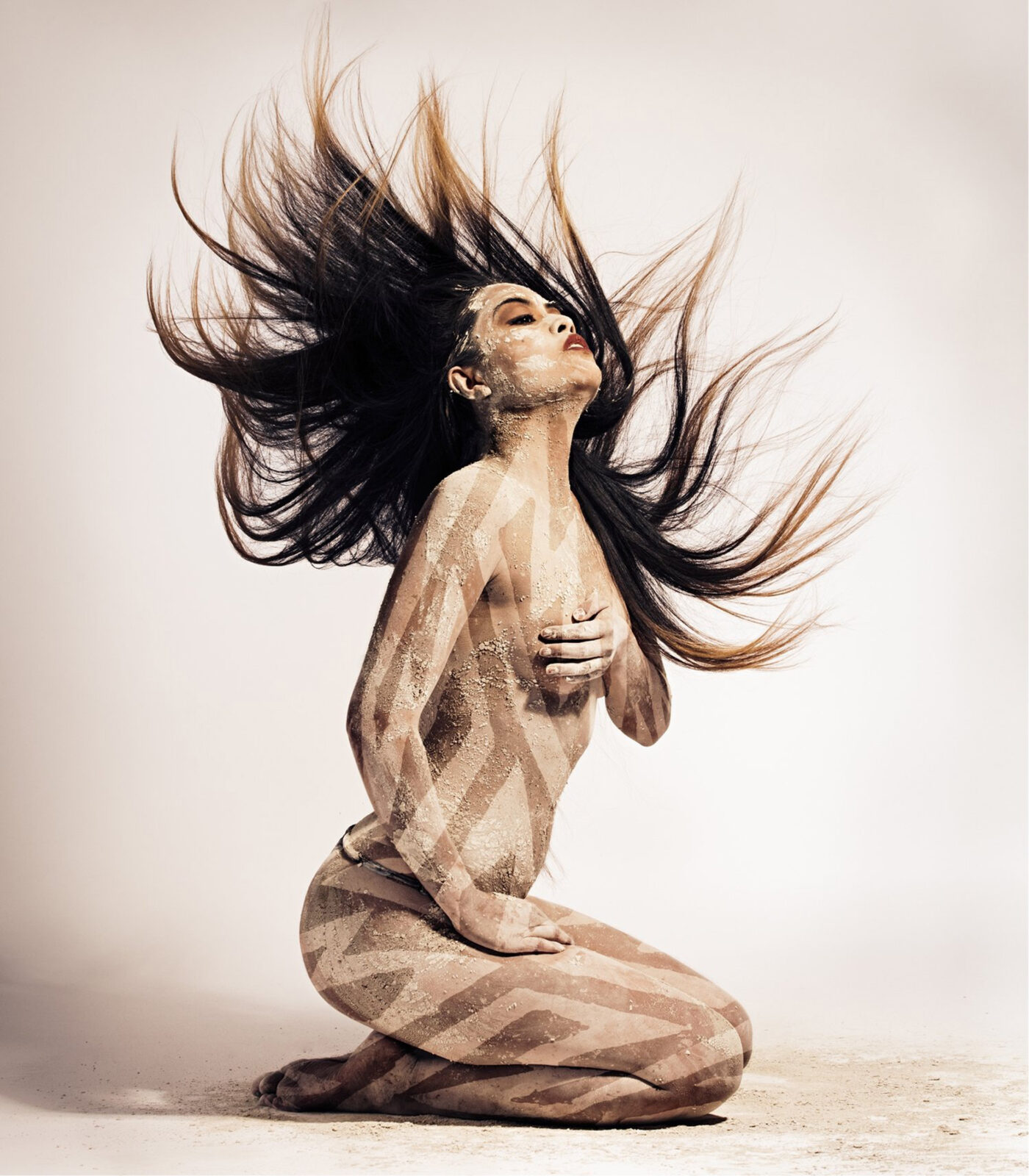
JEAnd it feels empowering and assertive because there’s been this historical aspect of hypersexuality focused on Native women. Having something that feels very much like an exploration of body sovereignty is really powerful as well.
CRIt is the one area of artwork that was kind of the scariest for me because it was another one of those things where I wasn’t seeing it done. The more I studied art around the world, the more I questioned: why we were studying the bodies of white women in art school? I uncovered policies at museums— specifically, Native museums that were like, “We will not collect nude Native art.” I think that those connections are really about body-othering and dehumanization. If you don’t have humanness and connection to Native women, I really think it does fuel epidemics of Missing and Murdered Indigenous Women. I believe in these storytellings of body sovereignty—as scary as they may be for me as a Native woman. I ask: if I feel this way, if this is my truth, then how can it be wrong? Those photographs are most well received by other women and other Native women. This is where you have to trust in the process and say, “This is okay to tell this story, even though it’s so vulnerable, because you might connect with another person that feels the same or needs the strength of this story.”
JEI want to jump into your current work which is really exciting for me because I am so drawn to this subject. Given the themes of your past work, it seems a natural trajectory that your latest genre is an exploration of Indigenous Futurism. I’ve also been exploring this in my own curatorial practice. I recently curated biskaabiiyang, an exhibition titled after an Anishinaabe word for returning to ourselves, our culture, our Indigenous ways of knowing to work towards a balance in ourselves and in the universe. I’m particularly interested in how we can utilize ancestral knowledge and storytelling as an art form. One of the artists in that exhibition, Coyote Park, had an artist statement that read:
Indigenous Futurism isn’t a fever dream: it is the heat of a fever and the burning desire of our existence.
As Native people, we have survived many apocalypses. We cultivate a future where our children are laughing, the water is drinkable, the plants are fruitful, and there is new growth after a forest fire. A settler colonial dream is a metal spaceship with a window that watches the burning of worlds and this dystopian plague of nations. The land is calling to be placed in the hands of those that it birthed.
I love what they get at here by thinking of futurism as something currently unfolding, in motion, not a destination but as an ongoing act, a survival, and that notion of Indigenous people living in our own post-apocalyptic world. You said in one of your artist talks that because we have been living in this constant state of a post-apocalyptic world—in a survival and passive resistance mode in which we have suffered a loss of worlds, ways of being, and language—there has been a disconnect between how we could measure or imagine future generations. Now that we are working towards language, arts, and cultural revitalization, there’s space for us to be hopeful and imagine what it looks like to be healthy in the future. Can you describe that hopefulness in your current Indigenous Futurism series?
CRI have been watching the genre myself, and it really goes back to being a young artist. I think often we emulate things that we love. I was seeing all of the Star Wars, the Native Star Wars and the Native Star Trek, and I was like, “Yes!” I was critically thinking about making work with these themes for a couple years. I wanted to consider this separateness from landscape and the disconnect from original instructions of regions, which goes back to the notion of dominion over nature that western society is known for, along with undervaluing the empirical science and the Indigenous science of all of these places that have been around for so long. We see these terms like “emerging biomimicry,” and I’m like, Okay, that’s an Indigenous worldview. We’re made to look at these ideas, rights of nature, as if they’re new. Native people and our global Indigenous communities hold a sacred role in the health and future of the planet. Everything is connected. How do we shake it up and help people understand it’s just a fact that you can’t undervalue: we will never be able to erase these original instructions of ways of living in reciprocity with Mother Earth.

As far as Western science goes, we’re seeing instances where things need to be undone so that there is a future, like undamming the Klamath River because hydroelectric energy is not going to work for the health of nature. So now we’re kind of hurtling forward, and as we imagine the future, our collective consciousness is very digital. The vision is very broadband and Bluetooth; it’s very the airwaves and the unseen. Yet we’re never going to survive unless we center the leadership and the knowing of Indigenous peoples.
For me this Indigenous Futurism series became about—kind of in that classic Cara sense of humor—the funness where we can imagine a future, but with the acknowledgement that we can never imagine it without the original instructions. We can be anywhere in time and place and with any sort of technology, but it’s never going to work unless we’re also uplifting original instructions. Those are really the most sophisticated sciences in the world, and they continue to be undervalued. That really became the cornerstone of where I wanted to go with the Indigenous Futurism work: going back to the beginning and saying, you’re never going to survive without the knowledge and the life-giving power of Indigenous women or without the slow-growth heirloom seeds of corn knowledge and corn technology. There’s really no more sophisticated science than those things. I would put those up against any technological advance of western science. Until we get back to that place of agreement, where we’re teaching those things in school and emphasizing the leadership of Native peoples and knowledge globally, I don’t think that our planet is going to repair or heal. The future is land repair and we’re seeing people call on Indigenous peoples to co-manage that process and asking us for the first time in 500 years about our knowledge. Amazingly, this knowledge still exists, and that excites me about the future. I think that all of our culture keepers are going to find themselves in a sacred role for the planet.
JEI also feel like there’s this different way of looking at past, present, and future: it’s not this linear thing, but time is walking alongside us. Sometimes the past is actually in front of us and the future is behind us in this interesting constant dialogue. Do you consider the use of magical realism and calling forth the supernatural into everyday life as integral to communicating an Indigenous worldview?
CRThe work I’ve made within the genre of Indigenous Futurisms really came from a deep creative space of wanting to play, of wanting to be imaginative, of wanting to talk about those connections to time and the power of Indigenous women.
When I was a young woman, probably around eighteen years old, prior to the internet or online reading, I went into a bookstore and found Love Medicine by Louise Erdrich. I read it, and then I immediately read it again. Then I went back to find more of Erdrich’s work and found Tracks and The Beet Queen and everything that I could get my hands on. That was my first mainstream experience, as a lonely Native person in the middle of the city, where I felt I just understood what she was doing creatively. The women could control the wind; there was no explanation in the text for why they could do that. But as a Native person growing up with mythos and growing up with songs about when animals were people, we didn’t need to question this. I was familiar with fables and allegories teaching us ways to live. This magical and supernatural part of everyday life was and is a teaching tool, a tool of connecting, a tool of talking about our spirituality, our deeper senses as human beings to each other and the natural world. When I was in a women’s literature class, I wrote my college paper on Louise Erdrich, and that was where I stumbled across the term magical realism. I didn’t ever imagine 20 years later that I would be incorporating it into my practice. While our tribes are so different, there are these moments where we can all connect to old stories that are still present with us and will be in the future, too. That’s my use of magical realism. I think it really allows people to come to a photograph with their own spirituality and with their own story. I don’t have to tell them what’s going on, but they can experience that for themselves. One of my favorite things about art is letting people feel what’s already inside of them.
JEI’m also thinking about this term resilience that has different meanings. I was recently in conversation with people of different generations. One was like, “This is a really powerful word, that we’re resilient.” The other felt sick of this word—tired of having resilience tied to part of our personality or part of our culture in general. What I find interesting about Indigenous Futurism is though we’re still using that word, its use also infers let’s go beyond, let’s see what’s going to happen in the future because we know that we’re already going to be here. There’s a power in having agency, having permanence.

CRI think that aspect of always bringing the past with us is important to being an Indigenous artist. I understand getting sick of categorizing words—we can throw contemporary and traditional in there also; in the Native arts world those are used ad nauseam. I think there was a push and pull that we saw as negativity among ourselves as Native artists of “you’re changing things, you’re not doing things the old way.’ I think there is this notion that we’re acting independently of each other and that this is causing our culture to divide on different paths. Like, oh, she’s taking the culture this way and we want to stay here on this path. I believe culture is not just this pond that’s sitting over here stagnant; it’s really a flowing river that’s going around boulders of boarding schools and technological advances and extraction of resources, and we’re really moving all together. I think that what’s beautiful about not only our Native people but our Native arts is that we’re moving together and that we don’t really exist without each other.
As contemporary artists, it may be the world that we live in, but we have still consider our weavers the backbones of our community and know that our young people are going to emerge and have both pathways to choose from, or choose both. I don’t exist as a contemporary artist without my traditional counterparts, and I have deep respect for those arts. This feels resilient and it feels like a necessity to consider interdependence and innovation. These are important conversations because we are at times held to strict cultural protocol as Native peoples. We’re not allowed to just do anything. Even as contemporary artists, we’re not allowed to depict certain things. There are taboos, and there are certainly things that are too culturally private and require really conscious decisions. But we also have this reality of our kids being on phones and consuming photographs and that being an amazing pursuit for a young Native person that they can feel good about. Then also just having that deep need and respect for people that are still purveying the arts that have been around for thousands of years because those are the ones that are interconnected with landscape and kinship and community.
JEThis week you’re showcasing works from your Indigenous Futurism series in Mexico City at the art fair ZONAMACO in a solo presentation with Bockley Gallery. Can you tell us more about these photographs?
CREven though the exhibited works share the theme of Indigenous Futurism—or just incredible modernity, of feeling futuristic through visual language and context—each are uniquely rooted in traditional practices. The women in 3 Sisters (2022) are friends I’ve worked with for several years, each from different tribes: one Ojibwe, one Pueblo, and one Kiowa, Comanche, and Blackfoot. 3 Sisters is about that sacred role that Indigenous people hold for the health of the planet and wanting to visually communicate with the wires that are plugged into the women. They’re plugged into their minds, their hearts, and, since Kaa was pregnant, the wires plug into her life-giving energy. Aesthetically it’s just very futuristic.
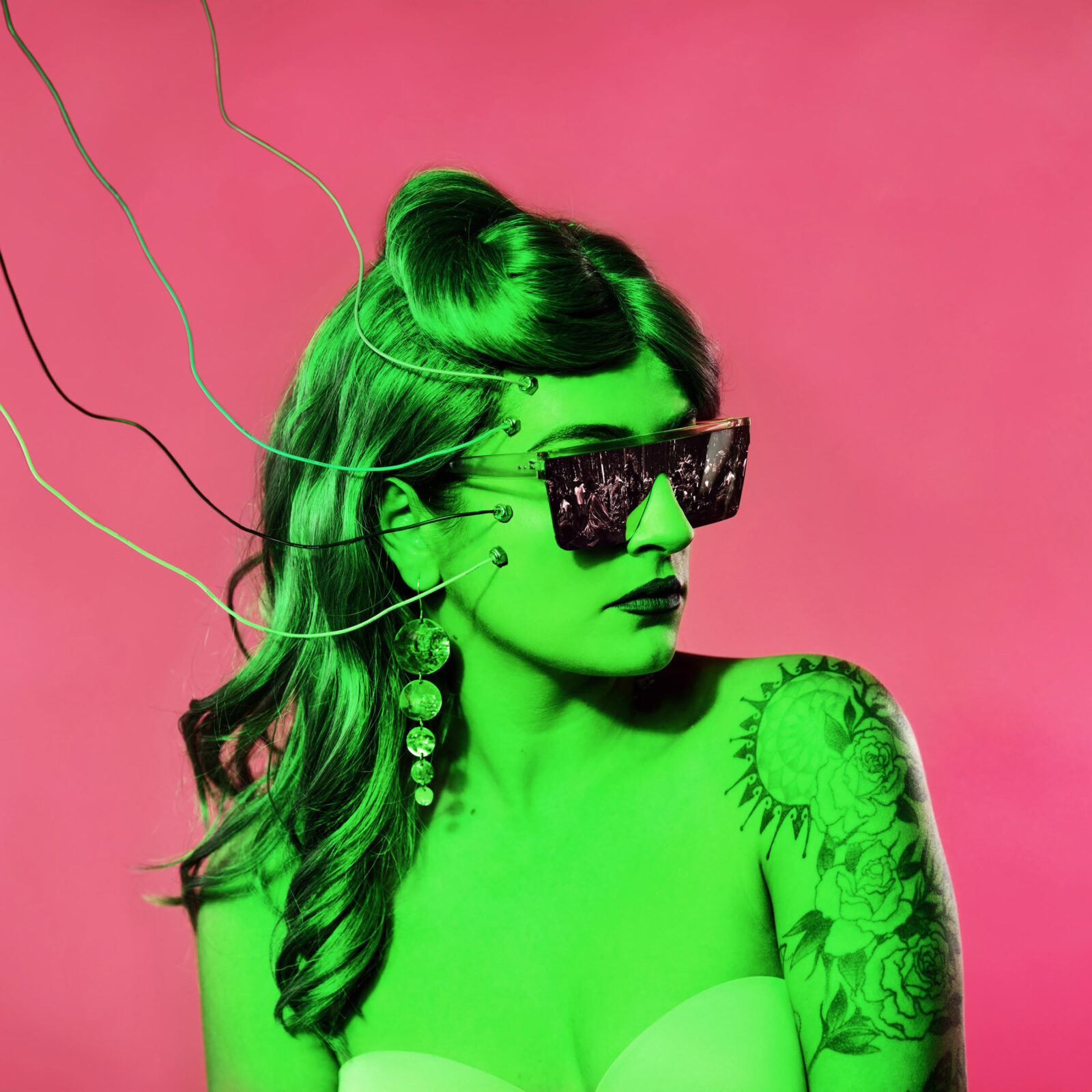
We don’t know what the future holds, but I thought it would be really fun to imagine a future where their tribal vernacular is digitally remastered onto their entire bodies. On the left is Leah Kakowski (Keweenaw Bay Ojibwe). For her “tattoos” I found a high resolution image of a 150-year-old beaded bandolier bag from her region that I digitally remastered. Kaa has ancestral Puebloan digitally remastered onto her skin. And PK, on the right, has her family’s flesh design in a repeated pattern, inverted and repeated over her skin. It really brought the piece together to also reference the three sisters of indigenous science gardens. Here, again, it’s me just asserting how sophisticated original sciences are and thereby asserting their importance.
I often use a repertory of my friends and family, who show up in my photographs over and over as themselves, but also different characters. In Gikendaaso, that’s Leah again and they’re plugged into her mind. Gikendaaso is the Ojibwe word for “she knows” or “she is knowledgeable,” “she’s educated.” Through Ojibwe language, it’s visually referencing the power of Indigenous intellect and how the world is going to need to plug into the knowledge of our Indigenous culture bearers, our Indigenous women, moving forward. Leah is also a photographer, so I asked her if in her sunglasses the reflection could be one of her own photographs that she’s seeing. She goes back as often as she can to photograph the powwow dances in Keweenaw Bay in the woods. They’ve been dancing in the same place for hundreds of years. That’s actually one of her black-and-white photographs that I digitally illustrated onto her glasses to give that sense of hopefulness. All these strategies help me say that no matter where we go, we’re going to take our really old practices with us because as Indigenous people we don’t exist without them. There is no future without all of the things that we’ve been able to hold onto and preserve for all of these years.
Zenith (2022) is very playful. I loosely reference the spaceman that we grew up with in Lost in Space. I’m from that era where these TV shows used to pop up on reruns every night. I had this moment where I thought of all of the weightlessness in images we see of space and imagined what that might be like to apply this. We have cousins that grow corn out at Cotati. I asked them if I could borrow some of their corn and they said yes. So, we went out and got a truck load of corn and then we spent hours tying up corn from fishing line at the studio. We created a contraption that the corn would be floating in space behind the person or around the person. We left a little space for him to sit in this kind of barber’s chair with a low back. He’s just leaning back in a chair with the corn floating all around him. Then in post-production, I very lovingly took the fishing lines out so that you can’t see them.

Often I’m asked by audiences and other photographers how the works are made. The combination of technologies—the theatrical and tactile staging in the studio for the camera with various lighting techniques paired with post-production digital care—really lends itself to that blending of supernatural and everyday life, that magical realism. It lends itself to the idea, again, that we can speculate the future, but as Native people, we’re going to be worried less about technological advances and more focused on how to bring first knowledge systems with us.
Juleana Enright (they/them) is a queer, Indigenous writer, curator, theater artist, and DJ living in Minneapolis. An enrolled member of the Lower Brule Lakota tribe of South Dakota, Juleana is the gallery and programs coordinator at All My Relations Arts. Their past roles have included culture editor for l’étoile magazine and communications specialist for Gamut Gallery. They have contributed to local platforms Pride Magazine, mplsart.com, Primer, and City Pages, and is currently a fellow of the MnArtists writers cohort. As an independent curator, Juleana has curated three art exhibitions and is a recipient of the Emerging Curators Institute 2020–21 Fellowship. Through their practice, Juleana strives to explore what it means to be a contemporary Native artist with focus on decolonization through art, ancestral knowledge, and reclaiming Native joy through existence, resilience and expression.